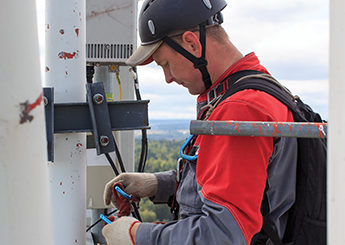'You can't subcontract safety'
OSHA, FCC host workshop on tower climbers

Washington – The safety of communication tower workers is an issue that has been growing nearly as fast as the rate at which new cellular and data towers have been appearing throughout the country.
Between 2011 and 2015, 36 workers died in communication tower-related incidents, according to OSHA. In April 2015, OSHA issued a Request for Information seeking feedback from stakeholders on how the agency can best work to prevent injuries and deaths during tower work. And on Feb. 11, OSHA and the Federal Communications Commission conducted a workshop to discuss comments received in response to the RFI and guidance on best practices for improving tower climber safety.
Culture
Stakeholders who attended the workshop pointed to a major safety issue they say the industry is facing: subcontracting employers who are not qualified to climb.
On sites with several subcontractors, no one knows who is working on that site – or if they’re trained, certified and insured, said Kevin Schmidt, who serves on the board of governors with the National Wireless Safety Alliance.
Although some panelists at the workshop believe adding safety requirements to contractual language will help subcontractors pay closer attention to safety, Wade Sarver is concerned that it may not be enough. Ensuring all workers are qualified on a site with multiple contractor levels could become challenging, and the work schedule may prompt employers to take shortcuts, warned Sarver, a wireless industry consultant and former tower climber.
Watch the workshop
“If you just confront someone and say ‘you’re not qualified to climb,’ the boss is going to come over and say ‘we need him today,’” Sarver said. “I’m not saying that’s the right culture; I am saying that’s the reality of the world in most cases.”
In fact, following the contract language actually may lead to an employer being “blacklisted” from future jobs, according to Nick Vespa, vice president of Tallahassee, FL-based Southeastern Towers. Vespa said workers face pressure to complete the job on time, which leads to working while tired even though the contract states that workers should not be fatigued. But if the subcontractor asks for more time to give employees rest, it may lose out on the next contract.
Sarver suggested hiring independent auditors to inspect sites for safety and check worker identification to ensure only qualified employees are climbing.
But John Parham of Pasadena, CA-based Jacobs Engineering Group took it a step further. Instead of simply auditing a site, Parham said, the safety culture of the entire company should be audited to identify gaps. He agreed that contract language is not enough to ensure a safe worksite, noting the worker is not thinking of contracts while on the tower. As such, a strong safety culture has to exist through all people involved with the project.
“You can’t subcontract safety,” Parham said.
In addition to technical training, Parham suggested training workers on being better professionals who care for one another and respond to safety concerns that are raised.
Design
Tower design also strongly influences how safe climbers can be, according to Angela Jones, a project engineer with Union Wireless in Wyoming. Towers should be built with more platforms and more dedicated tie-off points, Jones said.
Vespa claims many towers are overcrowded and covered on all sides with equipment, making it challenging for workers to navigate. These towers may provide only a notice that advises workers of potential climbing obstructions and recommends they use alternate fall protection means – without giving additional detail. This is not enough for workers to figure out how to safely get to the work, he said.
Richard Cullum disagrees. Cullum, a program manager with Houston-based Crown Castle, stressed that it is the responsibility of the contractor to have a competent person onsite who can resolve safety issues when they arise. “I believe the contractor is responsible for the means and methods to accomplish the job,” he said. “It’s no different than when you’re working on any kind of construction project, whether it be my house or a tower.”
But some employers may choose to have their workers “free climb” to get the job done quickly. In response to the idea of wireless carriers making it mandatory to use cranes or lifts on certain jobs that may have obstructions, Craig Lekutis, publisher of communication tower information portal WirelessEstimator.com, said it would be “wonderful” if the carriers came together and created joint standards for such situations.
Moderator Michael Janson, an associate chief at the Wireless Telecommunications Bureau, made it clear to the panelists that the solution to improving tower climber safety is not an either/or scenario – the responsibility is shared among all parties.
“Everyone in the contracting chain – everyone, from the carrier to the climber – can do something to improve safety,” Janson said.
Post a comment to this article
Safety+Health welcomes comments that promote respectful dialogue. Please stay on topic. Comments that contain personal attacks, profanity or abusive language – or those aggressively promoting products or services – will be removed. We reserve the right to determine which comments violate our comment policy. (Anonymous comments are welcome; merely skip the “name” field in the comment box. An email address is required but will not be included with your comment.)

